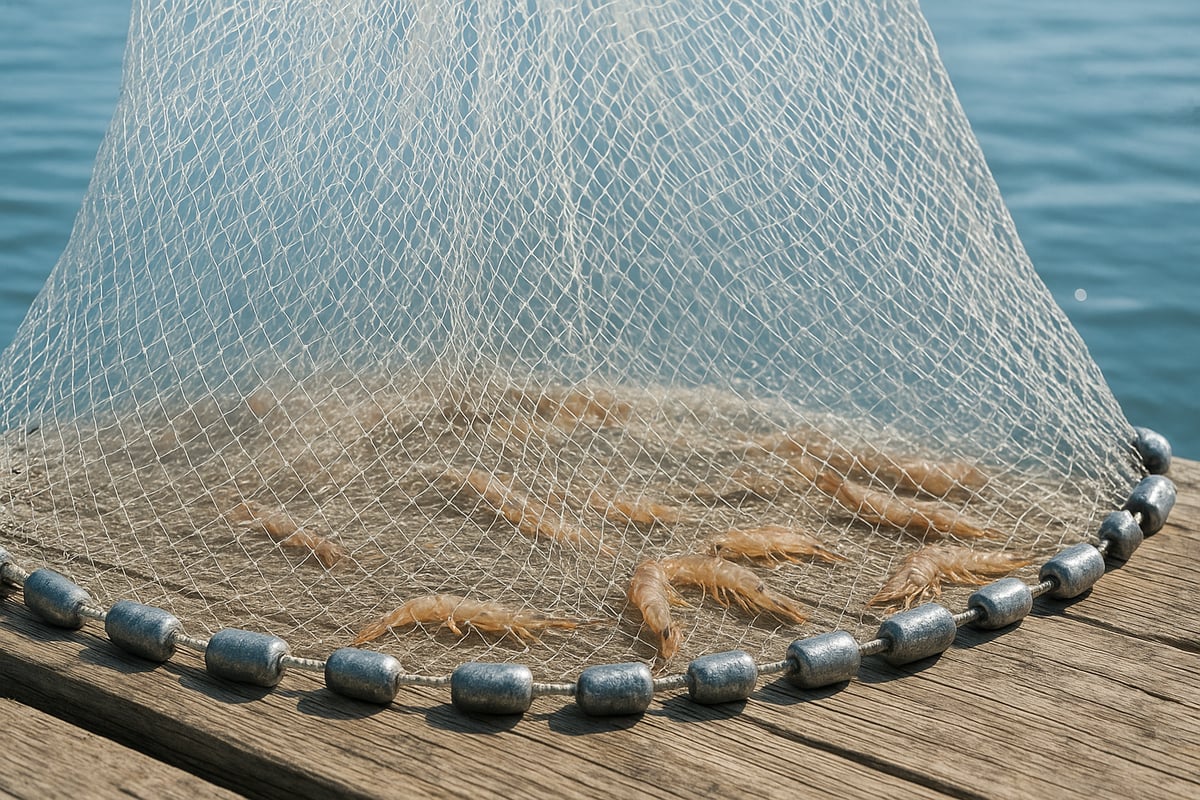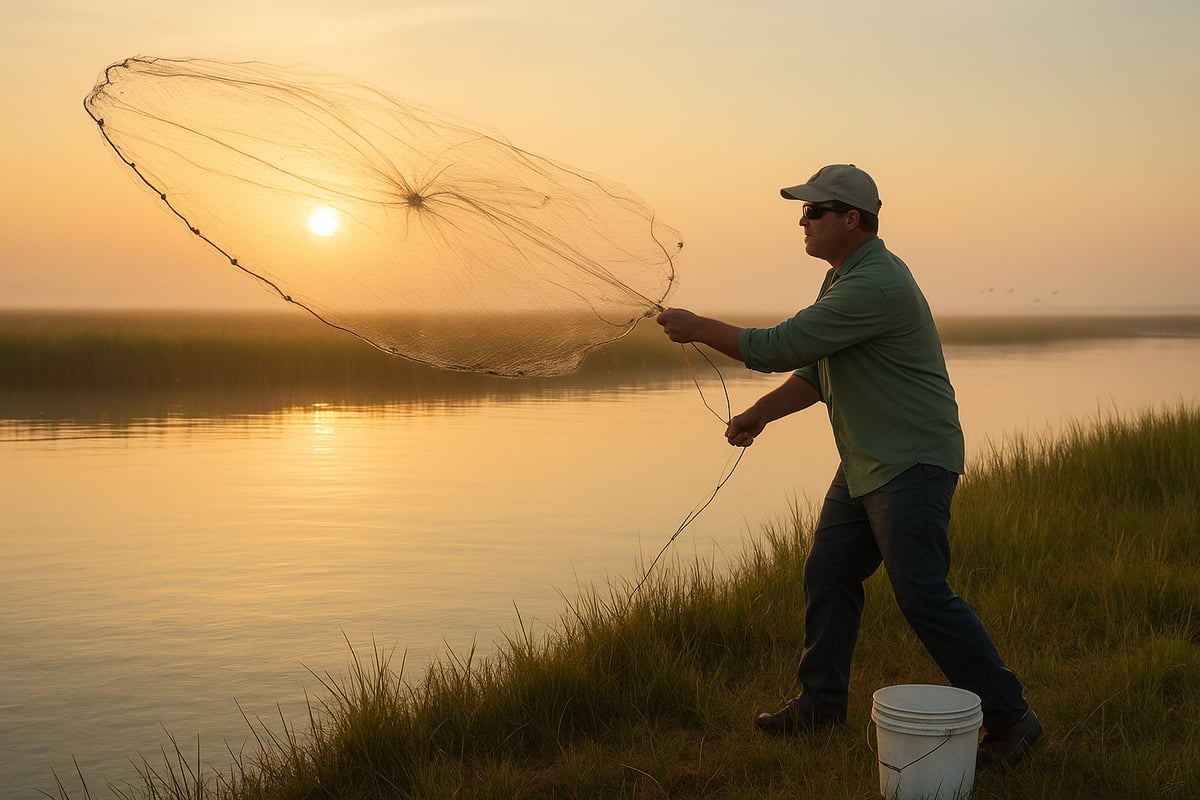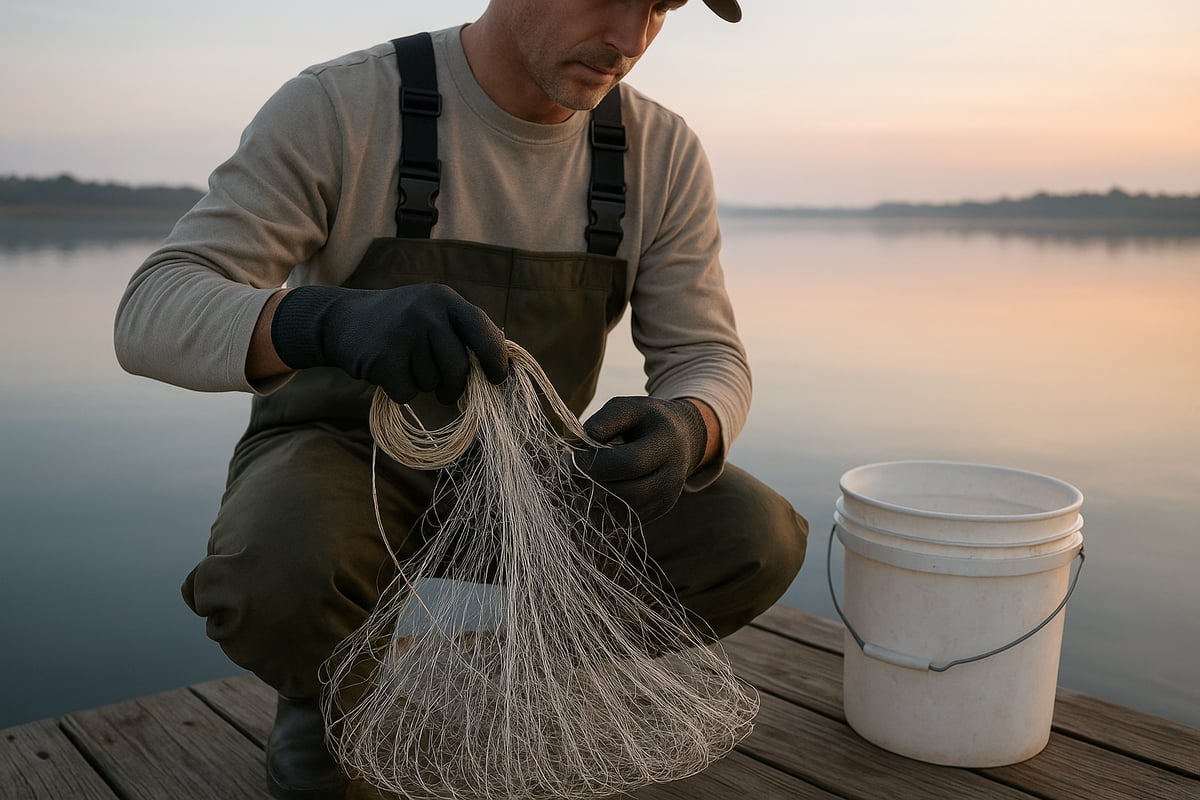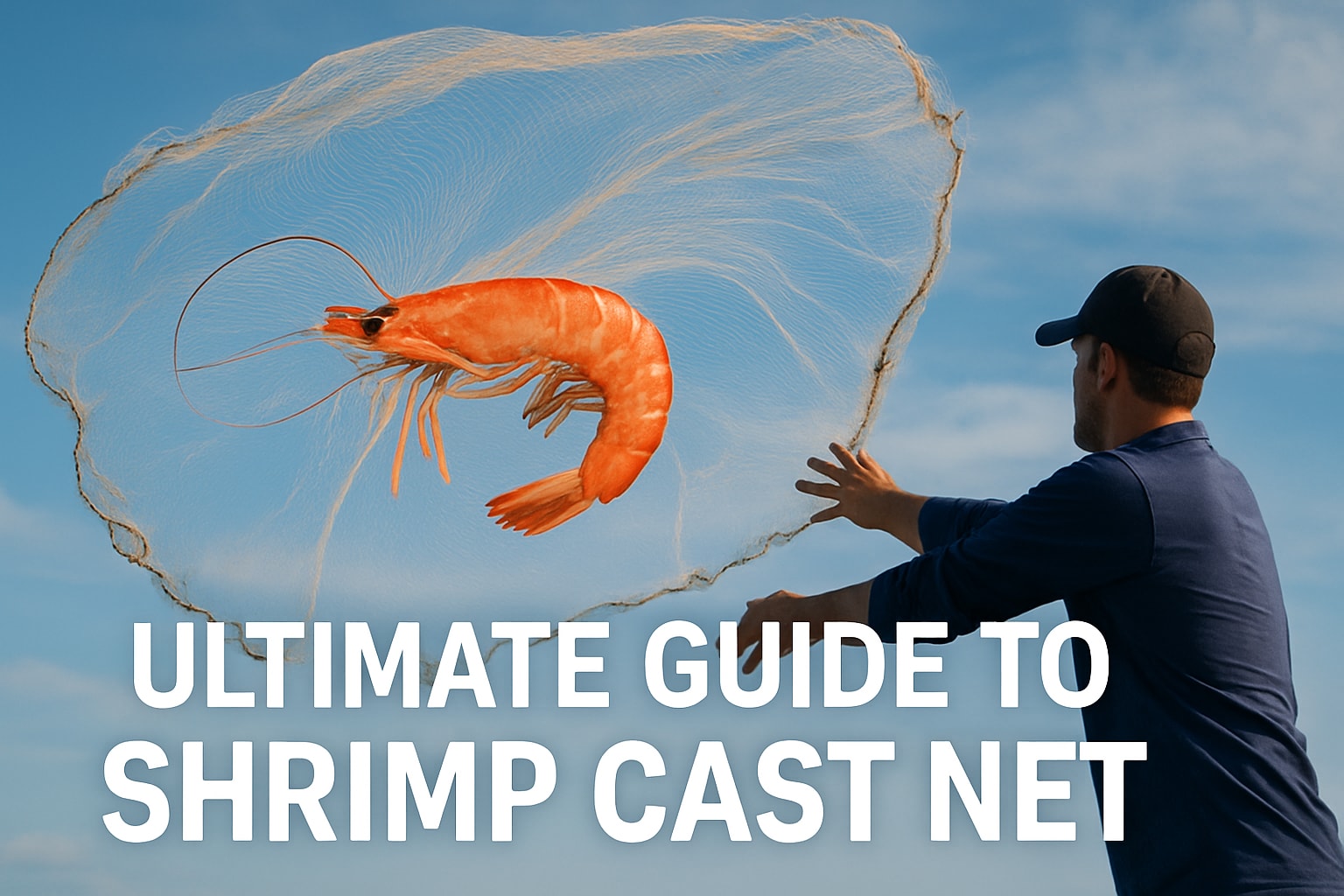Discover the secrets to catching more shrimp in 2025 with the latest methods trusted by both professionals and hobbyists. Shrimping has become increasingly popular, whether you enjoy it as a relaxing pastime or need fresh bait for your next fishing trip.
Mastering the shrimp cast net gives you a clear advantage. You save money, always have the freshest bait, and experience the excitement of each successful throw. Ready to improve your skills?
This comprehensive guide covers everything you need for shrimp cast net success in 2025. Learn about gear selection, scouting the best spots, throwing techniques, seasonal strategies, troubleshooting, and expert tips to boost your results.
Understanding Shrimp Cast Nets: Types, Sizes, and Key Features
Mastering the shrimp cast net begins with understanding its core design and purpose. These nets are circular, weighted fishing tools specifically crafted for capturing shrimp in shallow waters. Unlike standard fishing nets, a shrimp cast net is thrown by hand and sinks rapidly, trapping shrimp as it spreads and settles.
The mesh size and material are crucial for targeting shrimp. Finer mesh, typically 1/4 inch or 3/8 inch, prevents smaller shrimp from escaping while still allowing water flow. Materials range from durable nylon to advanced synthetics, each offering benefits for longevity and ease of handling. Common net sizes include 5 feet, 7 feet, and 10 feet in radius, each suited for different fishing environments and user strengths. Weight distribution around the perimeter affects how quickly the net sinks, which is vital for maximizing your catch.
| Net Size | Typical Use | Shrimp Size Targeted | Common Mesh |
|---|---|---|---|
| 5 ft | Beginners, tight spaces | Small-medium | 1/4", 3/8" |
| 7 ft | Versatile, most waters | Medium-large | 1/4", 3/8" |
| 10 ft | Deep water, experienced | Large | 3/8" |
A well-chosen shrimp cast net makes all the difference in both recreational and bait shrimping.

Overview of Shrimp Cast Nets
A shrimp cast net is engineered for efficiency and ease of use in both calm and moving waters. Unlike seine or dip nets, it is compact, portable, and relies on a circular spread to encircle shrimp quickly. The mesh size directly influences the species and size range you can target. Nylon is a traditional favorite for its flexibility, while modern monofilament and other synthetics increase durability and decrease drying time.
Net sizes determine coverage area and handling difficulty. Smaller nets (5 feet) are ideal for beginners or confined spaces, while larger nets (up to 10 feet) cover more area but require skill and strength. The placement and weight of sinkers around the edge ensure the net drops evenly and fast, crucial for shrimp that react quickly.
For a comprehensive breakdown of net sizes and their practical uses, see this American cast nets size comparison guide.
Choosing the Right Cast Net for Shrimping
Selecting the right shrimp cast net depends on several factors. Water depth, shrimp size, and your own experience level all influence the best choice. For shallow water and smaller shrimp, a 1/4 inch mesh allows for efficient trapping without excess drag. In deeper waters, a 3/8 inch mesh may sink faster and target larger shrimp.
Durability is key, especially for frequent outings. Look for reinforced stitching and corrosion-resistant weights. Maintenance matters too: rinse your shrimp cast net after every use and inspect for tangles or small tears. Leading brands for 2025 are introducing lighter, more robust materials and improved handline grips, making long sessions less tiring.
User experience also plays a role. Beginners may prefer smaller, lighter nets, while advanced shrimpers often use larger nets for greater coverage. Always match your net size to your physical ability to ensure safe and effective casting.
Essential Features for 2025
Innovation is reshaping the shrimp cast net market for 2025. Manufacturers are focusing on lighter, more durable synthetic fibers that reduce fatigue and extend lifespan. Modern nets feature improved handline lengths, allowing for better control and retrieval, especially in varying water depths.
Horn design is another area of advancement, with smoother, snag-free connections that streamline net opening and closing. Keeping up with regulations is critical, as legal mesh sizes and net diameters may change by region. Always verify local requirements before purchasing or using a new net.
Environmental considerations are also influencing design. Nets now offer reduced bycatch features, helping protect non-target species and sensitive habitats. By staying informed about the latest features and legal updates, you ensure your shrimp cast net not only increases your catch but also aligns with responsible fishing practices.
Essential Gear and Preparation for Shrimp Cast Netting
Getting ready for a successful shrimp cast net outing starts with assembling the right equipment. The right gear not only boosts your catch rates but also ensures safety and efficiency on the water.

Must-Have Gear
Every shrimp cast net trip should start with a checklist. The basics include:
- A reliable shrimp cast net sized for your target species and waters.
- A sturdy bucket or live well for holding your catch.
- Durable gloves to protect your hands from wet ropes and net weights.
- Waders or waterproof boots for wading in shallow spots.
- Polarized sunglasses to reduce glare and spot shrimp in the water.
When selecting your shrimp cast net, consider mesh size, weight, and materials. Modern nets designed for 2025 are lighter and more durable, making them easier to handle for all skill levels. For a deeper dive into gear options, consult the Shrimp nets for sale guide for up-to-date recommendations.
Gear Preparation and Safety
Before heading out, always inspect your shrimp cast net for tangles, holes, or damaged lines. Untangle the mesh and check that weights are evenly distributed, ensuring the net will open and sink properly.
Safety is vital. Handle net weights with care, as they can be sharp and cause injury. Wear gloves to prevent rope burns and cuts. If you are shrimping from a boat or near busy water, wear a life jacket and make yourself visible with bright clothing or a safety flag.
Organization and Clothing
Efficient shrimp cast netting depends on staying organized. Arrange your gear where it is easy to reach, whether on a boat deck or shoreline. Use dedicated containers for nets and accessories to prevent tangling.
Dress for the weather and water temperature. Waterproof boots or waders keep feet dry, while quick drying, layered clothing offers comfort throughout changing conditions. Polarized sunglasses are essential for spotting shrimp and reducing eye strain in bright sun.
Bait Additives and Environmental Considerations
Some shrimpers use bait additives or attractants to increase catch rates, especially in areas with lower shrimp density. Apply these products according to manufacturer instructions for best results.
Be mindful of the environment when using a shrimp cast net. Always minimize bycatch by checking your net frequently and releasing non target species quickly. Avoid sensitive habitats and follow local regulations to protect shrimp populations for future seasons.
Finding the Best Shrimping Spots in 2025
Locating the ideal spot is crucial for maximizing your shrimp cast net catch in 2025. Even the best technique will fall short if you are not targeting active shrimp habitats. Understanding where shrimp gather, how they move, and what environmental cues to look for will set you apart as a successful shrimper.

Understanding Shrimp Habitats and Movements
Shrimp tend to congregate in very specific environments. Mud banks, grass lines, and marsh drains are prime areas where you will often find large schools. These habitats provide both food and protection for shrimp, making them reliable targets for your shrimp cast net.
Tides play a significant role in shrimp movement. Outgoing tides and low tide windows are generally considered the best times to deploy a shrimp cast net, as shrimp are flushed out of cover and become more accessible. Water temperature, salinity, and clarity are also important. Warmer, slightly salty water with good visibility often signals active shrimp populations.
Watch for surface disturbances, jumping shrimp, or increased bird activity. These are strong indicators of shrimp presence. Paying close attention to these signs can help you decide exactly where to throw your shrimp cast net for the best results.
Tools and Technology for Locating Shrimp
Modern tools can greatly enhance your search for productive shrimping spots. Fish finders and portable sonar devices let you scan underwater for schools. GPS units and mapping apps help you mark productive areas and return to them during future trips. Many anglers also rely on local fishing reports and online community forums to share recent shrimp movement patterns.
Local knowledge is invaluable. Joining a fishing club or speaking with seasoned shrimpers can reveal hidden hotspots. Always check legal access rights and regional shrimping regulations before deploying your shrimp cast net. For example, if you plan to shrimp in Texas, you should review the Texas shrimping regulations 2025 to ensure compliance with all gear and area restrictions.
Seasonal and Regional Variations
Shrimping spots are not static throughout the year. As seasons change, so do the locations where shrimp are most abundant. In spring and summer, shrimp often move closer to shorelines and estuaries, while in colder months, they may retreat to deeper waters. Understanding these seasonal shifts is essential for effective shrimp cast net use.
Different regions host different shrimp species, each with preferred habitats. For example, white shrimp may favor muddy bottoms, while brown shrimp are often found near seagrass beds. Researching the dominant species in your area and their habits will help you select the optimal shrimp cast net location.
Top shrimping locations for 2025 include the Gulf Coast, Florida estuaries, and Georgia marshes. Staying informed about local conditions and adapting your shrimp cast net approach to the season and region will maximize your catch and enjoyment.
Step-by-Step Guide: Mastering Shrimp Cast Net Throwing Techniques
Mastering the shrimp cast net throwing process is both an art and a science. This guide breaks down each phase so you can confidently improve your efficiency and haul in more shrimp every trip.

Preparing the Net and Line
Before you make your first cast, setting up your shrimp cast net correctly is essential. Start by removing the net from its storage bag and laying it out on a flat surface. Inspect the mesh for tangles, knots, or signs of wear. Untangle any sections carefully to prevent snags during the throw.
Stretch the net gently to ensure all parts are moving freely. Next, check the handline for knots or twists. Coil the handline in loose, even loops so it will deploy smoothly when thrown. This step prevents the net from bunching up mid-air.
Pay special attention to the lead line. Make sure the weights are evenly spaced and securely attached. An even lead line helps the shrimp cast net sink uniformly, maximizing your catch rate. Take a few moments to verify the net is clean and free from debris. This preparation will save you time and frustration once you are on the water.
Loading and Holding the Net
Proper loading and grip are crucial for a successful shrimp cast net throw. Begin by holding the horn of the net in your dominant hand. With your other hand, gather the net's lead line until the mesh hangs evenly and the weights are off the ground.
For right-handed users, drape a third of the net over your left arm, then use your right hand to grab a section of the lead line. Some shrimpers prefer to use their mouth, while others use their fingers or a net bucket to hold the lead line. Choose the method that feels most comfortable and allows for a controlled release.
Adjust your grip based on net size and your own strength. Larger nets may require a two-step loading process, while smaller shrimp cast net models can be loaded in one motion. If you are left-handed, simply reverse the process. Practice loading until you can do it smoothly without tangling or dropping the net.
The Perfect Throw: Chronological Steps
A well-executed throw is the heart of effective shrimp cast netting. Start by facing your target area with feet shoulder-width apart. Hold the coiled handline in your non-throwing hand and the loaded net in your throwing hand.
Fold the net to create a loop, making it easier to swing and open fully. Swing the net in a circular motion, using your whole body for momentum. As you reach the apex of your swing, release the net with a flick of your wrist, allowing it to fan out in a wide circle.
Let the shrimp cast net sink naturally. The even distribution of weights ensures it descends quickly, trapping shrimp beneath. Wait a few seconds depending on water depth and current. Retrieve the net by pulling the handline steadily, lifting captured shrimp out of the water. Open the net over your bucket or live well and remove your catch efficiently to prepare for the next throw.
Troubleshooting Common Throwing Mistakes
Even experienced shrimpers encounter issues with their shrimp cast net. If the net fails to open fully, check for tangles in the mesh or uneven weight distribution. Lay the net out and untangle before your next throw.
If you notice the net bunches up mid-air, revisit your loading technique. Ensure the lead line is not twisted and the net is folded properly. For partial openings, a common fix is to adjust your stance and the swing angle.
Here are some quick troubleshooting tips:
- Practice your grip and loading with a dry net at home.
- Use marked practice spots to improve accuracy.
- If your throws are short, focus on using your hips for added power.
Regular practice and minor adjustments will help you achieve a consistently open throw and improve your shrimp cast net results.
Advanced Techniques for 2025
Once you have mastered the basics, advanced shrimp cast net techniques can further boost your catch. One-handed throws are ideal for kayak shrimping or when space is tight. This method involves coiling the net in one hand, then flicking it outward with a sharp wrist motion.
Double-throw techniques allow you to cover dense shrimp schools more efficiently. After the first cast, immediately reload and throw again to target any escaping shrimp. Watching video tutorials or joining clinics can accelerate your learning curve.
For a deeper dive into specialized methods and expert tips, check out this Cast net techniques and tips resource. Continuous learning and adapting your shrimp cast net approach will keep you ahead as techniques and equipment evolve.
Pro Tips and Strategies for Maximizing Your Shrimp Catch
Unlocking the full potential of your shrimp cast net requires more than just basic technique. By refining your timing, understanding shrimp behavior, optimizing catch handling, maintaining gear, and learning from experts, you can consistently boost your haul. The following strategies are tailored to help you maximize your results in 2025.
Timing and Tidal Strategies
Choosing the right time and tidal phase is crucial for shrimp cast net success. Outgoing tides and low tide windows often concentrate shrimp in accessible shallows. Early mornings or evenings tend to be the most productive, especially when water movement stirs up food sources.
- Check tide charts and plan trips around peak outgoing tides.
- Pay attention to moon phases, as new and full moons can increase shrimp activity.
- Always verify local regulations, such as those found in the Florida recreational shrimping rules, to ensure legal compliance with timing and harvest limits.
Strategically timing your outings helps you find dense schools and reduces wasted effort.
Shrimp Behavior Insights
Understanding how shrimp react to your shrimp cast net is essential for improving your catch rate. Shrimp are sensitive to shadows and vibrations, often darting away from disturbances. Observing their movement patterns can help you anticipate their responses and adjust your approach.
- Approach quietly and avoid sudden movements near the water’s edge.
- Cast slightly ahead of visible shrimp schools to intercept their path.
- Watch for surface ripples or jumping shrimp as signs of active feeding.
Adapting your technique to match shrimp behavior increases your chances of a successful net deployment.
Efficient Catch Handling
Once you land a haul with your shrimp cast net, quick and efficient handling ensures your catch stays fresh. Shrimp are delicate, and rough handling can lead to loss or spoilage.
- Transfer shrimp promptly to a live well or aerated bucket.
- Keep containers shaded and cool to maintain freshness.
- Use a wet towel to cover shrimp if fishing from shore.
Minimizing the time shrimp spend exposed helps preserve their quality for bait or table use.
Gear Maintenance and Longevity
Proper care of your shrimp cast net and related equipment extends their lifespan and maintains peak performance. Rinse your net thoroughly in fresh water after each use to remove salt and debris. Inspect for tangles, tears, or frayed lines before every trip.
- Store nets loosely coiled in a dry, shaded area.
- Repair small holes promptly to prevent them from worsening.
- For more detailed net care, explore this Fishing nets overview and care guide.
Routine maintenance not only saves money but also ensures your gear is always ready for action.
Expert Insights for 2025
Incorporate advice from seasoned shrimpers to adapt your shrimp cast net strategies for evolving conditions. Many experts recommend joining local fishing clubs or online forums to exchange tips and stay updated on seasonal trends.
- Share experiences and learn from community reports.
- Experiment with new techniques, such as one-handed throws in tight spaces.
- Study success stories from anglers who have improved their catch rates using innovative approaches.
Staying proactive and open to new ideas keeps your skills sharp and your shrimp buckets full.
Troubleshooting and Overcoming Common Shrimp Cast Net Challenges
Every shrimp cast net enthusiast encounters obstacles, even with the best preparation. Whether you are struggling with tangles, poor catches, or changing regulations, understanding how to troubleshoot these challenges can make a significant difference. Let us break down the most common issues and how to resolve them for a smoother, more productive shrimping experience.
Troubleshooting Net Issues
Net tangling and improper opening are frequent frustrations. Start by fully stretching and checking your shrimp cast net before each outing. Smooth out knots and inspect the mesh for snags. When loading the net, ensure the handline is coiled neatly and weights are not twisted. Practicing your throw with smaller nets can help you master the basics before moving to larger sizes. If the net consistently fails to open, review your folding technique and try adjusting your grip.
Improving Catch Rates and Handling Bycatch
If your shrimp cast net yields low numbers, reassess your location, timing, and technique. Experiment with different mesh sizes and weights to match local conditions. Sometimes, simply moving to a new spot or adjusting your throw to cover denser shrimp schools can boost results. When dealing with bycatch, gently release non-target species immediately to minimize harm. Using attractants sparingly can help increase shrimp catch rates while reducing unintended species in your net.
Coping with Weather and Environmental Factors
Adverse weather or murky water often leads to challenging conditions. Wear proper gear for safety and visibility, especially on slippery surfaces. If strong currents or wind affect your throw, position yourself to cast with the current and avoid overextending. Remember, environmental changes can influence shrimp behavior, so adapt your approach as needed. Always strive to minimize disturbance to sensitive habitats while using your shrimp cast net.
Legal and Regulatory Considerations for 2025
Stay updated on the latest shrimping laws to ensure your shrimp cast net meets all requirements. Regulations often change annually and may affect legal mesh sizes, net weights, and catch limits. For those shrimping in Georgia, the Georgia shrimping regulations 2025 detail current gear specifications and harvest rules. Additionally, keep an eye on national updates, such as those provided in the NOAA shrimp fishery updates, to ensure compliance with seasonal closures and protected areas. Upgrading your gear when regulations shift not only keeps you legal but can also improve your results.
As you explore the ins and outs of shrimp cast net techniques for 2025, having the right gear truly makes all the difference. From selecting the best net size to mastering advanced throwing methods, your success on the water starts with reliable, well crafted equipment you can trust. If you’re ready to put these tips into action and elevate your next shrimping adventure, take a look at the quality nets and marine gear available from New Zealand’s largest fishing net manufacturer. You’ll find everything you need to get started—just Buy Now.

